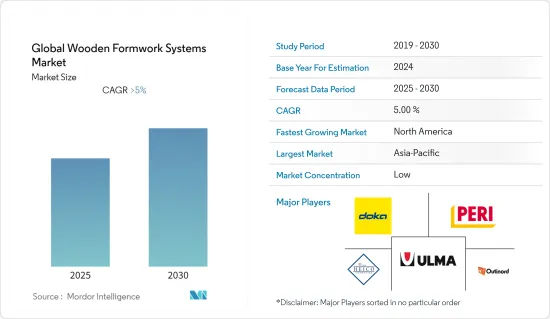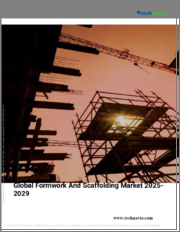
|
시장보고서
상품코드
1632089
세계의 목재 거푸집 시스템 : 시장 점유율 분석, 산업 동향과 통계, 성장 예측(2025-2030년)Global Wooden Formwork Systems - Market Share Analysis, Industry Trends & Statistics, Growth Forecasts (2025 - 2030) |
||||||
세계의 목조 거푸집 시스템 시장은 예측 기간 중 5% 이상의 CAGR로 추이할 전망

주요 하이라이트
- COVID-19의 발생은 부동산 및 건축 건설, 특히 거푸집 시스템에 사용되는 하드웨어에 많은 문제를 일으켰습니다. 바이러스 확산을 막기 위해 시행된 봉쇄 조치로 인해 건설 공급망이 정체되었습니다.
- 이러한 시스템은 거푸집, 클램프, 조인트, 지지대 등 다양한 부품으로 구성됩니다. 합판이나 목재 셔터가 더 저렴하고 쉽게 구할 수 있으므로 목재 거푸집 공사가 많이 사용됩니다.
- 목재 거푸집 시스템은 골격 또는 캣워크라고도 불리며, 목재 판자 또는 목재를 사용하여 임시 또는 영구 통로 또는 골격을 만듭니다. 거푸집은 작업자를 하늘에서 보호하고, 건물 벽의 벽돌을 재시공하거나 유틸리티 작업 중에 파이프를 덮는 등 시공이 필요한 표면에 작업자가 안전하게 올라갈 수 있도록 하는 데 사용할 수 있습니다.
- 중국 전나무는 크기가 변하지 않고 물이 들어가지 않기 때문에 시장에서 가장 인기있는 미끄럼틀 유형입니다. 그러나 건축 산업 수요가 증가함에 따라 목재 미끄럼틀 시장은 빠르게 성장하고 있습니다. 소나무를 사용한 미끄럼틀 시장은 다른 미끄럼틀에 비해 성장 속도가 느릴 것으로 예상됩니다. 지역별로는 북미가 미끄럼틀 시장을 주도하고 있으며, 유럽이 그 뒤를 잇고 있습니다. 아시아태평양은 인도, 중국 등 수요 증가로 인해 향후 수년간 가장 빠른 성장률을 보일 것으로 예상됩니다.
목재 거푸집 시스템 시장 동향
건설 산업 성장으로 시장 수요 촉진
앞으로 수년간 전 세계 건설 산업은 꾸준히 더 많은 자금을 가져올 것으로 예상되며, 2030년에는 2020년의 두 배 이상 규모에 달할 것으로 예상됩니다. 향후 수년간 신흥 시장의 건축 프로젝트가 증가함에 따라 건설 시장은 성장할 가능성이 높으며, 2022년 3월 호주 정부는 예산을 발표하면서 국내 인프라 프로젝트에 179억 호주 달러(약 134억 달러)를 추가로 투자할 것을 약속했습니다. 또한 호주 정부는 물 인프라 건설에 55억 호주달러(약 74억 호주달러)를 추가로 투자할 것을 약속했습니다. 전염병으로 인한 2년간의 침체기를 거쳐 2022년 인도의 상업용 건설 산업은 강력한 성장 궤도에 진입할 것입니다.
건설회사들은 인도 전역에서 수많은 새로운 상업용 건설 프로젝트를 시작했습니다. 말레이시아에서는 주요인프라 프로젝트의 부활과 함께 정부는 제12차 말레이시아 계획에 따라 사람들에게 저렴한 주택을 제공하는 것을 고려하고 있습니다. 그 결과 몇 가지 새로운 주택 프로젝트가 승인되었으며, 2022년 6월에는 Residensi Wilayah Keluarga Malaysia 프로젝트에 따라 약 6만 8,000채의 주택이 건설 승인을 받았습니다. 특히 제12차 말레이시아 계획에서 정부는 국내 50만 가구의 저렴한 주택을 공급하는 것을 목표로 하고 있습니다.
2022년 2월, 프랑스는 전 세계에서 7개의 중요 인프라 프로젝트 건설에 중국과 협력하는 첫 번째 국가가 되었습니다. 프랑스와 중국은 아프리카, 동남아시아, 동유럽 전역에서 17억 달러 상당의 7개의 중요 인프라 프로젝트를 공동으로 건설할 예정입니다. 프랑스는 전 세계 주요 건설 프로젝트에 자금을 투입하고 있으며, 다른 국가들이 프랑스내 인프라 프로젝트에 자금을 투입하도록 장려하고 있습니다. 스위스는 2022년 5월 프랑스 인프라 프로젝트, 특히 프랑스 라인 라인 라인에 투자할 가능성이 있다고 밝혔습니다. 사우디아라비아는 국민들이내 집 마련을 용이하게 하기 위해 국내 여러 지역에서 많은 새로운 주택 프로젝트를 시작했습니다. 사우디는 국민 3분의 2 이상이 주택을 소유할 수 있도록 하는 전략의 일환으로 리야드, 사우디 서부의 메디나, 홍해 서부의 지다항 등 7개 주요 도시에 15만 채의 주택을 건설하는 프로젝트를 시작했습니다. 한 업계 단체에 따르면 전체 건설 시장 규모는 2021년 8조 2,000억 달러, 2030년에는 14조 4,000억 달러에 달할 것으로 예상하고 있습니다. 이러한 건축 산업의 큰 성장은 사람들이 목재 거푸집 시스템을 구매하려는 큰 이유가 될 것으로 보입니다.
환경 악영향으로 인한 시장 도전 가능성
전 세계 대부분의 건축물에 목재 프레임이 사용됨에도 불구하고 전 세계에서 산림이 벌채되고 있습니다. 전 세계 인류 사회는 수천년동안 목재를 건축자재로 사용해 왔습니다. 목재는 생물학적으로 중요한 유일한 건축자재이기 때문에 우리는 당연히 건축에 목재를 사용하는 것이 환경에 좋다고 생각하는 경향이 있습니다. 사실 목재 사용으로 인한 환경적 이점은 간단하지 않습니다. 목재는 자연의 산물이지만 건조와 가공에 많은 에너지가 사용됩니다.
그 대부분은 나무 자체의 바이오매스로부터 얻을 수 있지만, 이를 위해서는 공장에 대한 투자가 필요하며, 많은 소규모 생산자에게 광범위하게 분산되어 있는 산업에서는 반드시 가능하지 않습니다. 목재는 또한 삼림 파괴의 주요 원인이기도 합니다. 전 세계 자연림에서 채취되는 목재의 약 1/3이 목재 제품에 사용됩니다. 삼림 벌채의 대부분을 차지하는 국가에서는 목재 제품이 전체의 약 10%를 차지합니다. 삼림 벌채와 산림 황폐화는 기후 변화와 생물 다양성 손실을 유발하는 중요한 요인이며, 현대의 두 가지 중요한 환경 문제입니다. 산림, 특히 열대림은 엄청난 양의 탄소를 축적하고 있습니다. 산림이 파괴되면 그 탄소가 대기 중으로 방출되어 지구 온난화를 가속화합니다.
유엔식량농업기구(FAO)의 추정에 따르면 1990-2020년 4억 2천만 헥타르, 즉 유럽연합(EU)의 면적보다 더 넓은 면적의 산림이 삼림 파괴로 인해 사라졌다고 합니다. 순면적 손실(벌채된 산림 면적과 새로 심거나 재생된 산림 면적의 차이)로 볼 때, FAO는 같은 기간 중 전 세계에서 약 1억 7,800만 헥타르의 산림이 손실된 것으로 추정하고 있으며, 이는 프랑스 면적의 3배에 해당하는 규모입니다. 삼림 파괴는 열을 빼앗는 총 배출량의 약 10%를 차지하며, 이는 자동차 6억 대가 1년 동안 배출하는 양과 거의 비슷합니다. 건축에 목재를 사용하는 데 따른 이러한 부정적인 영향은 시장 성장을 억제하는 요인이 될 수 있습니다.
강철과 같은 대체 재료는 환경 친화적이고 재활용이 가능하며 수명이 깁니다. 벌목을 줄이고, 산림을 보호하고, 지구 온난화와 온실 효과를 줄이거나 막을 수 있습니다. 철골 거푸집은 건설 폐기물을 줄이는 데 도움이되는 설치 비용이 많이 들기 때문에 중소규모의 건축업자는 사용할 여유가 없을 수 있습니다. 목재는 쉽게 구할 수 있고 저렴하며 다루기 쉽습니다. 반면 강철은 용접공과 복잡한 용접 장비가 필요합니다. 따라서 목재의 단점에도 불구하고 건축 산업, 특히 구조 부문에서는 여전히 많이 사용되고 있습니다.
목재 거푸집 시스템 산업 개요
세계 목재 거푸집 시스템 시장은 세분화되어 있고 경쟁이 치열합니다. 경쟁과 가격 경쟁이 심화되고 새로운 투자자와 개발자가 시장에 진입하고 있습니다. 또한 목재 거푸집 공사에 대한 수요 및 공급이 모두 증가하고 있습니다. 시장에서 활동하는 주요 기업으로는 Doka, PERI, ULMA, Acro, The Heico Companies LLC, MEVA Systems Inc. 등이 있습니다. 전 세계에서 건설 프로젝트가 증가함에 따라 신규 시장 진출기업이 시장에 쉽게 진입할 수 있는 여건이 조성되고 있습니다. 하지만 이러한 소규모 업체들은 기존 대형 업체들과의 치열한 경쟁에 직면해 있습니다. 시장 선도 기업은 다른 기업과 경쟁하기 위해 다양한 제품을 제공합니다. 신생 기업은 혁신적인 제품과 기술 통합을 통해 시장 진입을 시도하고 있습니다.
기타 혜택
- 엑셀 형식의 시장 예측(ME) 시트
- 3개월간의 애널리스트 지원
목차
제1장 서론
- 조사의 전제조건과 시장 정의
- 조사 범위
제2장 조사 방법
- 분석 방법
- 조사 단계
제3장 개요
제4장 시장 역학과 인사이트
- 시장 개요
- 시장 성장 촉진요인
- 시장 성장 억제요인
- 시장 기회
- 밸류체인/공급망 분석
- 산업의 매력 - Porter's Five Forces 분석
- 구매자/소비자의 교섭력
- 공급 기업의 교섭력
- 신규 진출업체의 위협
- 대체품의 위협
- 경쟁 기업 간 경쟁 관계
- 정부의 규제와 시책
- 이 부문에서 기술개발
- 시장에 대한 COVID-19의 영향
제5장 시장 세분화
- 슬라이드 유형별
- China Fir
- 목재
- 송재
- 합판
- 용도별
- 건물
- 운송
- 산업시설
- 지역별
- 북미
- 유럽
- 아시아태평양
- 중동 및 아프리카
- 기타
제6장 경쟁 구도
- 시장 집중 개요
- 기업 개요
- Doka
- PERI
- ULMA
- Acrow
- The Heico Companies LLC
- Outinord
- MFE Formwork Technology Sdn.Bhd
- Urtim Formwork and Scaffolding Systems
- Waco International
- MEVA Systems Inc*
제7장 시장의 미래
제8장 부록
KSA 25.01.31The Global Wooden Formwork Systems Market is expected to register a CAGR of greater than 5% during the forecast period.

Key Highlights
- The COVID-19 outbreak caused a lot of problems in real estate and building construction, especially with the hardware used in formwork systems.The lockdowns that were put in place to stop the spread of the virus slowed down the construction supply chain.This hurt the market for wooden formwork systems, which led to less demand and less money for companies in the market.
- Most of this growth is due to more money being put into infrastructure projects and more construction projects being started.Formwork systems made of wood are used to control the shape and size of buildings as they are being built or rebuilt.These systems are composed of a number of different parts, including forms, clamps, joints, and supports. Most wooden formwork systems are made of wood because it is strong enough to stand up to the forces that are put on it during construction but also flexible enough to fit the shapes of buildings.Wooden formwork is more in use because plywood and wood shutters are cheaper and more accessible.
- Wooden formwork systems, also called scaffolds or catwalks, are made from wooden boards and timbers to make temporary or permanent walkways or scaffolds. The formwork can be used to protect workers from the sky and help them get up safely on a surface that needs to be built, like repointing the bricks in a building's wall or covering pipes while doing utility work, etc.
- China fir is the most popular type of slide on the market because it stays the same size and doesn't let water in. But the market for slides made of wood is growing faster because there is more demand from the building industry. The market for pine wood slide types is expected to grow at a slower pace as compared to other slide types due to a lack of awareness among buyers about its advantages. In terms of geography, North America leads the slide-type market, then Europe. Asia Pacific is expected to witness the fastest growth rate in the next few years owing to increased demand from countries such as India and China.
Wooden Formwork Systems Market Trends
Growing Construction Industry to Fuel the Demand in the Market
Over the next few years, the construction industry around the world is expected to steadily bring in more money. In 2030, it is projected to be more than twice as big as it was in 2020. Over the next few years, the construction market is likely to grow because there are more building projects in emerging markets. In March 2022, when the Australian government released its budget, it promised to spend another AUD 17.9 billion (USD 13.4 billion) on infrastructure projects in the country.In addition, the Australian government has promised to spend another USD 5.5 billion or AUD 7.4 billion on building water infrastructure.After a two-year slump caused by a pandemic, India's commercial construction industry is on a strong growth path in 2022.
Construction companies have started a number of brand-new commercial construction projects across India. Alongside the revival of key infrastructure projects in Malaysia, the government is also looking to provide people with affordable housing under the 12th Malaysia Plan. Consequently, several new housing projects have received approval in the country. In June 2022, nearly 68,000 homes received construction approval under the Residensi Wilayah Keluarga Malaysia project. Notably, under its 12th Malaysian Plan, the government aims to provide 500,000 affordable homes in the country.
In February 2022, France became the first country to partner with China in building seven key infrastructure projects globally. France and China will jointly build USD 1.7 billion worth of seven key infrastructure projects across Africa, Southeast Asia, and Eastern Europe. France is putting money into important building projects around the world, and the country is also trying to get other countries to put money into infrastructure projects in France. Switzerland said in May 2022 that it might invest in infrastructure projects in France, especially the French Rhine Line. Saudi Arabia has started a number of new housing projects in different parts of the country to make it easier for people to buy their own homes. As part of its strategy to boost the ownership of houses to at least two-thirds of the Kingdom's people, Saudi Arabia launched projects to build 150,000 houses in seven key cities, such as Riyadh, Medina in western Saudi Arabia, and the western Red Sea port of Jeddah. According to an industry group, the construction market as a whole was worth USD 8.2 trillion in 2021 and is expected to be worth USD 14.4 trillion by 2030. This huge growth in the building industry will be a big reason why people want to buy wooden formwork systems.
Negative Environmental Impact Might Create Challenges for the Market
Even though timber framing has been used in most buildings around the world, forests have been cut down all over the world. Human societies around the world have used timber as a building material for thousands of years. As wood is the only significant biological building material, we are naturally inclined to believe that using wood in construction is good for the environment. As a matter of fact, the environmental benefits of using timber are not straightforward: although it is a natural product, a large amount of energy is used to dry and process it.
Much of this can come from the biomass of the tree itself, but that requires investment in plants, which is not always possible in an industry that is widely distributed among many small producers. Wood is also a major driver of deforestation. About a third of the wood extracted from natural forests worldwide is used for timber products. In the countries that account for most of the deforestation, wood products contribute about 10% of the total. Deforestation and forest degradation are important drivers of climate change and biodiversity loss, the two key environmental challenges of our time. Forests, especially tropical forests, store enormous amounts of carbon. When forests are destroyed, that carbon is released into the atmosphere, accelerating global warming.
The Food and Agriculture Organization of the United Nations (FAO) estimates that 420 million hectares of forest - an area larger than the European Union - were lost to deforestation between 1990 and 2020. In terms of net area loss (the difference between the area of forest cleared and the new surface of forests planted or regenerated), the FAO estimates that the world lost around 178 million hectares of forest cover in the same period of time, which is an area triple the size of France. Deforestation accounts for around 10% of total heat-trapping emissions-roughly the same as the yearly emissions from 600 million cars. This negative impact of using wood in construction may become a restraint on market growth.
Alternatives like steel are better for the environment, can be recycled, and can last for a long time. They can cut down on logging, save forests, and reduce or stop global warming and greenhouse effects. Even though using steel formwork helps cut down on construction waste, it costs a lot to set up, so small and medium-sized building contractors may not be able to afford to use it. Timber is easy to get, cheap, and easy to work with. Steel, on the other hand, needs welders and complicated welding equipment. So, even though wood has some bad effects, it is still used a lot in the building industry, especially in the structural sector.
Wooden Formwork Systems Industry Overview
The global wooden formwork systems market is fragmented and highly competitive. Competition and pricing have increased strongly, and new investors and developers have entered the market. Moreover, both the demand and supply of wooden formwork are increasing. Some key players operating in the market include Doka, PERI, ULMA, Acro, The Heico Companies LLC, MEVA Systems Inc., etc. The increasing number of construction projects across the globe makes it easier for new players to enter the market. Still, these small players face fierce competition from established major players. The major players in the market mostly offer a wide range of products to have a competitive edge over other players. Start-ups try to break into the market with innovative products and technology integration.
Additional Benefits:
- The market estimate (ME) sheet in Excel format
- 3 months of analyst support
TABLE OF CONTENTS
1 INTRODUCTION
- 1.1 Study Assumptions and Market Definition
- 1.2 Scope of the Study
2 RESEARCH METHODOLOGY
- 2.1 Analysis Methodology
- 2.2 Research Phases
3 EXECUTIVE SUMMARY
4 MARKET INSIGHTS AND DYNAMICS
- 4.1 Market Overview
- 4.2 Market Drivers
- 4.3 Market Restraints
- 4.4 Market Opportunities
- 4.5 Value Chain / Supply Chain Analysis
- 4.6 Industry Attractiveness - Porter's Five Forces Analysis
- 4.6.1 Bargaining Power of Buyers/Consumers
- 4.6.2 Bargaining Power of Suppliers
- 4.6.3 Threat of New Entrants
- 4.6.4 Threat of Substitute Products
- 4.6.5 Intensity of Competitive Rivalry
- 4.7 Government Policies and Regulations
- 4.8 Technological Developments in the Sector
- 4.9 Impact of COVID-19 on the Market
5 MARKET SEGMENTATION
- 5.1 By Slide Type
- 5.1.1 China Fir
- 5.1.2 Timber
- 5.1.3 Pine Wood
- 5.1.4 Plywood
- 5.2 By Application
- 5.2.1 Buildings
- 5.2.2 Transportation
- 5.2.3 Industrial Facilities
- 5.3 By Geography
- 5.3.1 North America
- 5.3.2 Europe
- 5.3.3 Asia-Pacific
- 5.3.4 Middle-East and Africa
- 5.3.5 Rest of the World
6 COMPETITIVE LANDSCAPE
- 6.1 Market Concentration Overview
- 6.2 Company Profiles
- 6.2.1 Doka
- 6.2.2 PERI
- 6.2.3 ULMA
- 6.2.4 Acrow
- 6.2.5 The Heico Companies LLC
- 6.2.6 Outinord
- 6.2.7 MFE Formwork Technology Sdn.Bhd
- 6.2.8 Urtim Formwork and Scaffolding Systems
- 6.2.9 Waco International
- 6.2.10 MEVA Systems Inc*



















